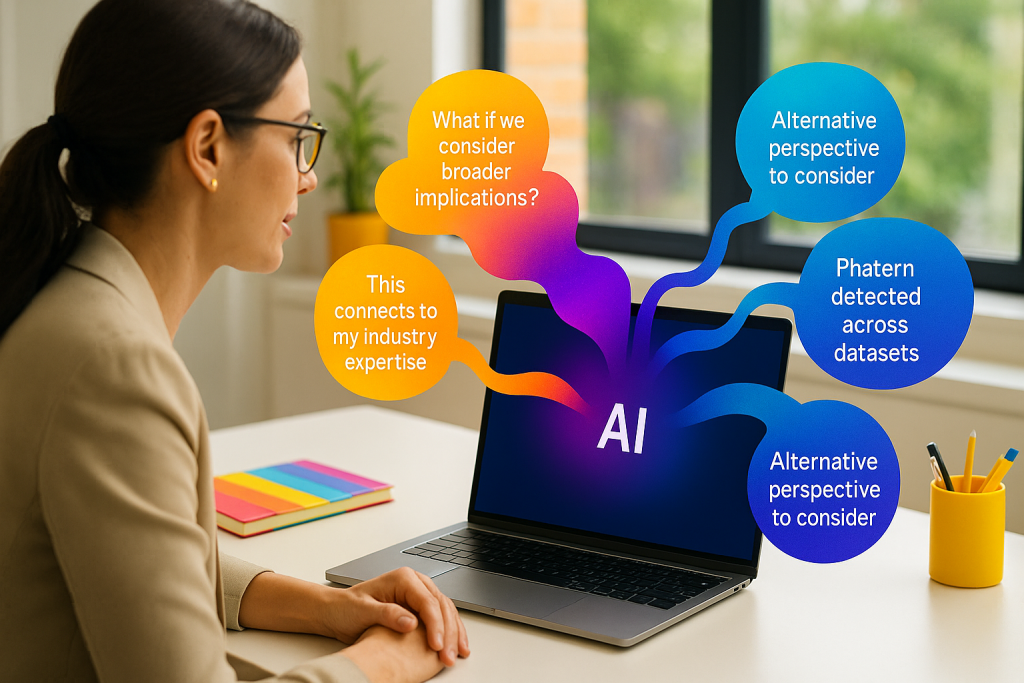
Last night, I gave a webinar on deep research forecasting, bias mitigation, and fact-checking when working with large language models. Among the guidelines I shared was a recommendation that caught some attention: construct your conversations with AI models like GPT by starting with wider-lens questions before progressively narrowing your focus.
During the Q&A session, an attendee raised an interesting question: “Why can’t we just put our full prompt in one time? Wouldn’t that be more efficient?”
It’s a fair question—and one that deserves a thoughtful response. The answer lies not just in optimizing AI outputs, but in recognizing the remarkable potential that emerges when human and machine intelligence work together in a genuinely collaborative process. This approach isn’t merely about getting better responses from AI—it’s about creating a synergy between two different forms of intelligence to achieve what neither could accomplish alone.
True Augmented Intelligence: The Power of Two Minds
Augmented intelligence is not about humans directing AI or AI enhancing humans independently—it’s about creating a genuine partnership where both forms of intelligence contribute their unique strengths:
- Human Intelligence: Critical thinking, contextual understanding, ethical judgment, creative direction, and domain expertise
- AI Intelligence: Pattern recognition, rapid information processing, connection-making across vast knowledge bases, and language generation
The progressive conversation approach creates the ideal conditions for this partnership to flourish. Rather than treating AI as a simple tool to be prompted correctly, this method establishes a collaborative thinking space where ideas can evolve through meaningful exchange.
Why Progressive Conversations Create Better Results
The progressive approach optimizes both AI performance and human-AI collaboration in several ways:
- Enhanced AI Understanding: Starting with broader questions allows the AI to establish a stronger foundational understanding before addressing specifics.
- Human Agency and Direction: Each step creates space for human evaluation and course correction, keeping human judgment at the center of the process.
- Emergent Insights: The back-and-forth exchange often surfaces unexpected connections and perspectives that neither human nor AI would have identified independently.
- Balanced Attention: Breaking complex queries into steps helps the AI focus appropriately on each element rather than prioritizing certain aspects at the expense of others.
- Nuanced Exploration: Progressive narrowing allows for deeper investigation into areas that prove most fruitful during the conversation.
- Learning Through Dialogue: Both the human and the AI develop better understanding through the iterative process, building on each response to create richer insights.
A Real-World Example of Augmented Intelligence in Action
Let’s compare approaches to see how augmented intelligence emerges through progressive conversation:
One-Shot Approach: “Analyze the impact of climate change on agriculture in Southeast Asia, including economic implications, adaptation strategies for small farmers, government policy recommendations, and compare with other tropical regions, providing detailed statistical evidence, while ensuring you avoid Western-centric perspectives and consider indigenous farming practices.”
Result: A comprehensive but potentially shallow response where the AI makes all the connections independently, with limited opportunity for human direction or insight integration.
Progressive Augmented Intelligence Approach:
- Human: “What are the major climate change impacts affecting agriculture globally?”
- AI provides foundation of knowledge
- Human evaluates, identifies gaps or bias in the response
- Human: “How are these impacts specifically manifesting in Southeast Asia?”
- AI applies global knowledge to regional context
- Human contributes regional expertise or redirects if needed
- Human: “What economic implications do these changes have for small-scale farmers in the region?”
- AI identifies patterns across economic data
- Human brings in ethical considerations and prioritization
- Human: “I notice indigenous farming practices haven’t been addressed. How might traditional knowledge contribute to adaptation strategies?”
- Human directs exploration to an overlooked area
- AI connects traditional practices to modern challenges
- Human: “Based on our discussion, what approaches seem most promising for policy development?”
- Together, human and AI synthesize insights from the entire conversation
- Human applies contextual judgment to AI’s pattern recognition
The progressive approach creates multiple points of human input and direction, while leveraging the AI’s ability to process information and identify patterns. The final outcome reflects a true synthesis of both intelligences rather than either working alone.
Finding Your Optimal Human-AI Partnership
While the progressive approach typically creates stronger augmented intelligence, there are situations where different approaches make sense:
- One-Shot Directions work well for straightforward tasks with clear parameters where human evaluation of the output is sufficient
- Semi-Structured Guidance combining a foundational prompt with follow-up refinement offers a middle ground
- Fully Progressive Dialogues provide the richest collaborative environment for complex, nuanced problems requiring significant human judgment
The most effective approach isn’t about optimizing the AI in isolation, but about creating the right conditions for human and machine intelligence to enhance each other. With practice, you’ll develop an intuitive sense for how to structure conversations that leverage the best of both intelligences for your specific needs.
Embracing the Augmented Future
As AI capabilities continue to advance, the most powerful applications won’t come from AI working independently or from humans merely directing AI as a tool. The greatest potential lies in creating genuine intellectual partnerships where human and machine intelligence augment each other.
The progressive conversation approach I described in my webinar isn’t just a technique for getting better AI outputs—it’s a framework for creating true augmented intelligence. By maintaining meaningful human involvement throughout the process while leveraging AI’s unique capabilities, we create a synergy where the whole truly becomes greater than the sum of its parts.
In this framework, AI becomes not just a tool we optimize but an intellectual partner we collaborate with. The conversation itself becomes the medium through which augmented intelligence emerges—something neither human nor AI could achieve independently.
What has your experience been with different approaches to human-AI collaboration? I’d love to hear your thoughts in the comments below.